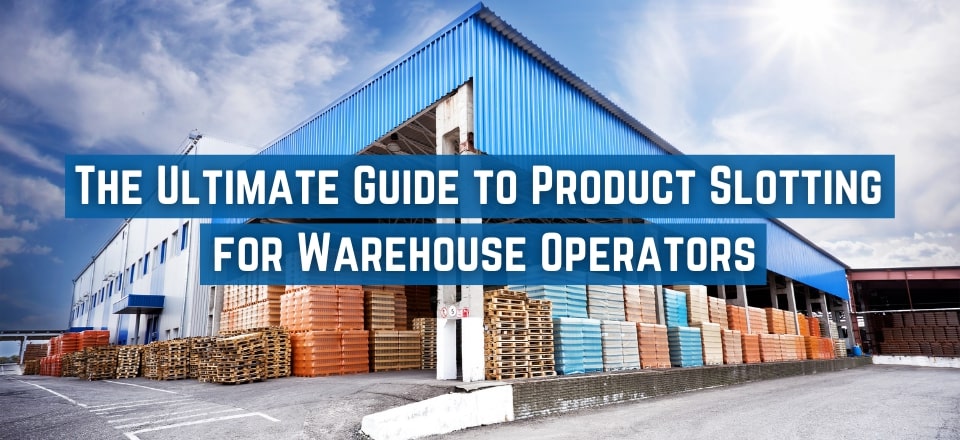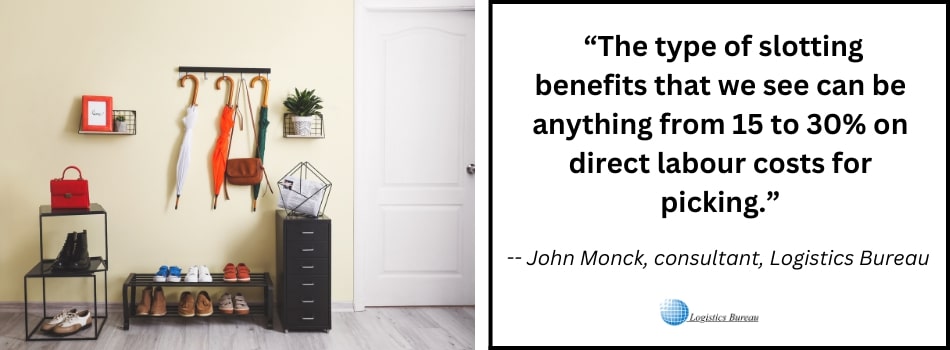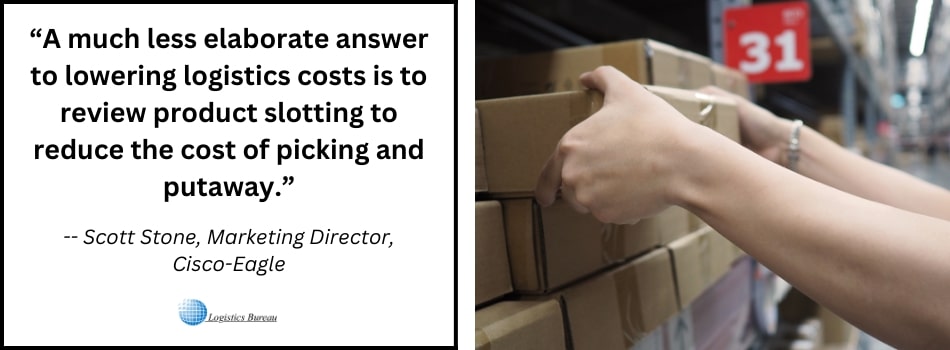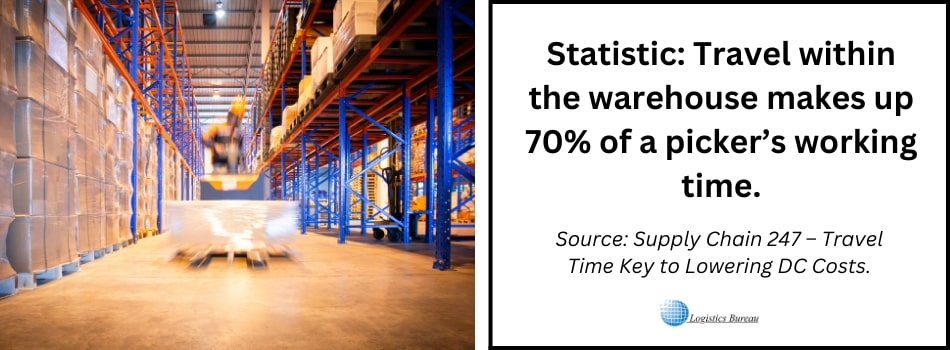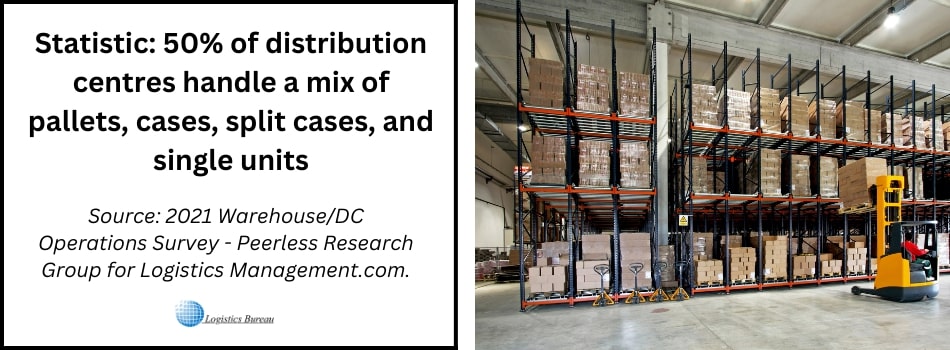If you browse through the Logistics Bureau blog, you’ll find at least two or three articles—and about the same number of videos—that cover warehouse product slotting.
However, the incredible benefits of slotting make it worth exploring some more, and we’ve never published a complete and comprehensive guide to the practice.
So here it is—your ultimate guide to warehouse product slotting. It covers everything from the “why” through the “how” to the “when, where, and what.”
Whether you have never heard of slotting before, or are a slotting aficionado who’s always looking for new insights into the practice, you’ll find something in this piece that will make you glad you came across it.
What is Product Slotting
As this is an “ultimate” guide, we’ll start with the basics. In case you’re not aware, product slotting is a concept that’s every bit as simple as it sounds, even if it’s quite a bit more complex in practice.
Slotting is the assignation of specific warehouse SKUs to discrete locations in the warehouse.
Slotting a warehouse product is the same, for example, as placing your umbrella close to your front door at home, so it’s easy to pick it up and run when it’s raining, and you’re late for work.
Slotting is all about optimising the placement of warehouse SKUs to gain efficiency, increase productivity, and reduce operational costs. Beyond these benefits, when slotting is done correctly, it’s also advantageous from health, safety, and service perspectives.
Why Implement Slotting in Your Warehouse?
As briefly mentioned, product slotting offers benefits that cross the entire spectrum of warehouse management. Still, without a doubt, picking is the operational regimen that will see the most significant impact.
That’s why slotting is such a worthwhile initiative, because picking is the activity that consumes the most labour hours in the warehouse, perhaps constituting 50%, or even more, of total person-hours.
With that in mind, then, how does a picking productivity gain of up to 20%, or perhaps more, sound? Or a similarly sized reduction in warehouse labour costs? Pretty good, right? And that’s what your organisation can achieve with the right approach to warehouse slotting practices.
Of course, as this is an ultimate guide to product slotting, it would only be fitting to leave you with a statement about the cost benefits if it includes an explanation of how they come about. So here are the reasons why slotting can be such an advantageous element of warehouse management.
Slotting Improves Picking Accuracy and Speed
Because product slotting is all about organising warehouse SKUs into specific sections, aisles, and locations in the warehouse, it enables faster picking when done appropriately.
For example, slotting strategies often involve placing the fastest-moving SKUs close to the warehouse dispatch zones, minimising picking operatives’ travel distances and times.
However, sometimes different approaches are necessary. For instance, if a warehouse operation involves picking a large variety of SKUs by the carton, case, or “each,” pickers might follow specific routes through the warehouse—and that might mean they can’t simply shuttle between the dispatch zone and the nearest storage locations.
In that type of scenario, the gains in accuracy and speed might be better achieved by slotting products intelligently along the aisles. So, for instance, SKUs commonly ordered together are located close to one another. The aim should be for each turn around the pick faces to be as short as possible for the pickers.
Faster Picking – Fewer Mistakes
Travel between item locations makes up a substantial part of the distance pickers will cover during their shifts. Therefore, any slotting strategy should focus on minimising such travel.
Whether slotting the fastest moving products nearest to the dispatch zone or slotting for efficient routes up and down aisles, the aim should always be to cut down the total travel time.
How does this optimisation of SKU placement improve accuracy as well as speed?
There’s nothing magical about it, honestly. It’s simply because slotting typically creates a warehouse environment in which the picking teams know where each SKU is likely to be stored. So, it’s that, along with the visibility improvement from creating a more ordered warehouse interior, which reduces the frequency of picking errors.
That said, even with warehouse slotting in effect, it’s vital to determine very carefully where each SKU should go. If not, there is a risk of increasing rather than minimising picking errors.
For instance, while it typically makes sense to locate items often ordered together in adjacent locations, exceptions exist. In many cases, products that share marked similarities are better located several bins apart, on opposite sides of an aisle from one another, or even in different aisles.
That will reduce the possibility of the wrong SKU being picked due to mistakes in visual recognition. Scenarios like this highlight how critical it is, when slotting, to think about SKU placement from all angles and why the slotting process can be complex, even if the concept is simple.
Slotting Creates a More Usable Warehouse Footprint
Here at Logistics Bureau, we’ve helped countless warehouse operators to implement slotting strategies and we get a ton of satisfaction from seeing our clients’ surprise at the gains in picking productivity. Honestly, though, the most outstanding visual satisfaction comes from the noticeable difference in how a warehouse looks after the slotting results have been implemented and all the SKUs are in their defined locations.
If you want some help with your slotting, contact us here
It’s important to note, though, that slotting benefits are not merely aesthetic. A slotting project typically reveals opportunities to increase space utilisation. In some cases, after slotting, seemingly full warehouses are shown to have pockets of unused space sufficient for the operators to shelve plans for warehouse expansion or relocation.
Slotting Reduces Harm to Products – and People
This benefit is probably more of a side effect rather than a primary goal of product slotting, but one that nonetheless highlights why slotting is such a critical facet of effective warehouse management.
We’ve already discussed how slotting improves productivity by reducing travel time in the warehouse. However, less travel means less traffic and fewer touches to merchandise, so straight away, it reduces the risk of product damage and loss.
A detailed exploration of slotting methodology will come later in this article, but it’s worth mentioning now that slotting should focus on inventory ergonomics (for want of a better expression). It’s not just about the best lateral placement of each SKU, but also where in the vertical space they are best stored.
When implemented correctly, slotting ensures that each product is stored appropriately for its throughput and characteristics. That means reduced exposure to risks of injury caused by lifting, bending, or working at height.
Slotting Increases Replenishment Efficiency
If warehouse product slotting increases productivity and efficiency in picking, thereby reducing warehouse costs, it stands to reason that it does the same for replenishment and put-away activities.
It also stands to reason that when you undertake a slotting exercise, you should think about it from the perspective of these activities.
So, for instance, in addition to slotting products in the pick faces, you should also consider slotting the bulk of your inventory to optimise pick-face replenishment—that’s if you operate scenarios where you don’t pick directly from SKU bulk storage locations.
If you get this right, you’ll add additional warehouse cost savings to your slotting gains, won from superior placement of all storage locations, not just those in the paths of your picking teams.
Slotting Benefits: Summary
So now we’ve established that a properly executed slotting strategy can bring benefits that include…
- Productivity improvements in picking, replenishment, and put-away
- An increase in picking accuracy
- More effective utilisation of your warehouse space
- Reduced risk of product loss/damage
- A safer workplace for your warehouse team
… And that all of the above leads to lower warehouse operating costs and hence, increased profit for your business. So let’s move on and look at how to do it.
Slotting Terminology: Don’t Get Hung up on the Macro and Micro
Before we get too deep into the how-to part of this guide, it might be time to head off any potential misconceptions about a couple of terms you will often hear slotting experts discuss.
Those terms are macro slotting and micro slotting. However, there is no mystery to their meaning, and it rarely makes too much sense to dwell on any distinction between them. The terms merely relate to the level of detail you assign to your slotting strategy.
Whether using a fixed or dynamic strategy, the only pure application of slotting takes place at the micro level. When you hear a reference to macro-slotting, it merely means a looser approach involving the division of the warehouse space into zones.
While it’s possible to argue that, as an “ultimate” guide, this article should cover macro slotting, we see that much more as an element of warehouse layout design. Therefore, we prefer to focus on the precise location of products at the SKU level when we apply our consulting resources to a slotting project—and hence to consider that the critical subject matter in a slotting guide.
If you want some help with your slotting, contact us here
Slotting by the Numbers: Data is the Key
Warehouse product slotting is very much a data-driven activity, so your first task will be to gather the data necessary to make precise slotting calculations. Those calculations, of course, will necessitate using some digital software.
While it’s possible to use a spreadsheet application like Microsoft Excel for slotting, your task will probably be easier if you have access to a dedicated application that can run slotting algorithms.
Many warehouse management system applications have integrated slotting capabilities, too, so if you’re running one of those, you should undoubtedly use the functionality that supports slotting.
Product Slotting Data Requirements
Regardless of which tool you use, you’re going to need the correct information to run the calculations, which means that typically, you will want to feed the following data into your software:
- Throughput velocity for each SKU
- Warehouse dimensions (aisle lengths, rack heights, and others)
- Slot dimensions (cubic capacity of each slot)
- SKU dimensions (weight and cubic size)
- SKU families (groups of SKUs that are typically ordered or sold together)
- Picking level (are products picked by the single unit, case, or pallet?)
- Any special storage requirements
The above list of data types is not exhaustive, and additional data requirements may exist depending on the nature of your business and its warehousing characteristics. In any event, expect to draw on much of the data captured in your sales or ordering history and SKU master data records.
But what if your business lacks the digital tools necessary to use the data? In that case, you will need help from a logistics consulting provider who can perform the required modeling for you.
At Logistics Bureau, our warehouse consultants are equipped with best-of-breed software for product slotting and the necessary know-how to model scenarios and determine an optimal slotting strategy for your facilities.
Product Slotting Tactics
Now that we’ve covered the “what” and “why” of warehouse product slotting, let’s progress to the “how.” There’s a lot to think about, especially if your product range is substantial and diverse. So, we’ll begin by looking at tactics for products with specialised storage needs.
Accommodating Special Storage Needs
Apart from the technical aspects of special storage, slotting products with specific storage requirements is relatively straightforward. In most cases, you will keep all products with shared special storage needs together in a zone with the appropriate equipment and environment.
Naturally, if your company specialises in such products, your entire warehouse might be devoted to special storage. If so, your approach to slotting will be as for a regular dry storage warehouse.
Products with special storage needs might include:
- Items of very high value (they will need a secure storage zone)
- Hazardous products (they will need storage that isolates and protects them)
- Temperature-sensitive or frozen products (they will need cold storage facilities within the warehouse)
Grouping Product Families
Tactics for product family grouping are simple enough. If your business supplies a mix of products that sell randomly and others that often ship together, you should try to locate those that ship together in adjacent slots, to speed up the picking process.
However, things get somewhat more complicated when you have conflicting objectives, such as slotting by velocity and slotting in product groups. Fortunately, it’s common for product families to share similar velocity metrics. Still, it might not always be the case, and sometimes there are tradeoffs to evaluate as part of the slotting process.
Using Throughput Velocity as a Basis for Slotting
The pace at which products move out of the warehouse is the metric that logistics managers typically prioritise in a slotting project. The most common way to determine the velocity is through ABC analysis, using order lines as the velocity indicator. The idea is to get the products picked most often stored at the front of the warehouse, closest to the dispatch zone.
Note that this means an item picked 100 times over a given period—regardless of how many units are picked—would have priority over an item picked just ten times in that same period, even if this latter product was picked in far larger quantities than the former. That’s because it’s all about picking frequency rather than sales volume, so the product with more picks is the one that gets the most accessible slot.
Beware the Fast-Mover Bottleneck
While determining slots based on picking frequency sounds simple, it can be less straightforward in practice. For example, what if you have a lot of fast-moving products?
Placing them all in one aisle or all at the dispatch-zone end of the aisles could introduce congestion, leading to a slotting strategy that causes more problems than it solves. Therefore, you should consider spreading those fast movers out around the warehouse, or using a secondary metric as a basis for prioritization.
The entire decision-making process also depends on the picking methodology you employ in your warehouse.
Given that many warehouses combine full-pallet picking by forklift with manual pallet building for smaller orders and perhaps some other methods, it’s easy to see how slotting optimisation can become quite a conundrum. That’s why it can pay to get help from a consulting team that works with slotting strategies all the time.
Slotting for the Future
Before we move on, here’s one last tip that you might find helpful. When you analyse the picking velocity of your products, you will naturally want to use your order history. However, we recommend that you incorporate forecast velocity if possible.
After all, once you have completed your slotting project, the last thing you want is to find that some SKUs placed in the most accessible slots start to decline in popularity and that others overtake them.
While regular re-slotting is a recommended practice, you don’t want to have to do it within a few months of the original exercise.
SKU and Slot Dimensions
The interrelationship between slot size and SKU dimensions is a complicated but critical consideration in a warehouse product slotting project.
Slot sizes should be determined by the SKUs that will go into them and the rate at which those SKUs will be picked. However, you must also be aware that slot dimensions impact picking efficiency.
For example, the wider your slots, the further your pickers will need to travel to pass those slots to get to others. On the other hand, smaller spaces will need refilling (replenishing) more often than larger ones. That is one of the typical tradeoffs in warehouse slotting.
Aim for More Picks Per Slot
There is no easy solution to determining slot sizes, but as a general rule, you should aim to get as many picks as possible with minimum travel for your pickers.
Suppose, for instance, you have a slot that’s 1.3 metres in length, and you have to choose between a bulky product and several smaller products to fill it.
Before deciding, it will be prudent to calculate if you will get more picks from loading that slot with the smaller products. Or does the larger one move fast enough to make it worth prioritising for that slot?
Also, don’t forget to consider each SKU’s handling characteristics and the equipment your team uses for picking. That will help you determine which products belong in ground-level slots and which can go higher up in your racking.
4 Bonus Slotting Tips
So far, we have covered most of the fundamental considerations for product slotting in a warehouse and have shared principles which, if you abide by them, will steer you on the path to slotting your products effectively. Before we conclude, though, here are a few extra tips to help you enjoy success with warehouse slotting.
1: Vertical Slotting Considerations
Do you store some of your warehouse inventory on shelving? If so, use the floor-level bays of your racking for heavier products and place the fastest movers in your lighter-weighing product categories on your low shelving, which should ideally be between knee and chest height for your pickers. Slower-moving products which are not heavy or bulky can go onto your higher shelves.
2: Engage Your Picking Team in Your Planning
Nobody knows your warehouse and its challenges better than those who pound its aisles daily. While slotting is primarily a numbers exercise, data can’t tell the whole story. Your picking team holds irreplaceable knowledge about the warehouse layout and how you could improve it. Pickers have insight into the constraints and opportunities that the numbers don’t reveal, and their input can vastly enhance your slotting effectiveness.
3: Consider Other Warehouse Processes in Your Plans
Picking is the process that can receive the most significant benefits from slotting. However, it can also give you gains in other areas, so remember to consider tasks such as inventory counting, replenishment, and put-away when making your slotting plans.
4: You Don’t Have to Slot Everything
Most warehouse operations handle some products that have minimal impacts on workload, efficiency, or cost. You should be able to identify such items during your data evaluation, so you can set them aside and exclude them from your slotting strategy. Therefore, determining individual slot locations for every SKU in a warehouse is rarely necessary and can even be unhelpful.
Product Slotting: Not an Event, But a Habit
Of all the slotting mistakes we see in our role as consultants, the biggest and most detrimental one is treating it as a one-time event or, in other words, failing to establish a habitual approach to the task.
Every slotting layout’s effectiveness and efficiency has a shelf life, so if you want to benefit from product slotting, you need to revisit your strategy regularly and adjust it as circumstances dictate.
If sales of your products vary in volume with the seasons, you will need to take a seasonal approach to warehouse slotting and make adjustments as those volumes fluctuate.
If your business runs promotions and campaigns, you might need to re-slot to prioritise the products under promotion and then do so again after a campaign ends.
And it’s improbable that your product mix stays the same indefinitely, so re-slotting is a task to undertake every so often to keep up with the changes in your SKU range.
Even if your range doesn’t change that much, a best-selling item today might become a slow mover next year, so at the very least, a six-monthly or annual review of your slotting plan will be prudent.
How a Good WMS can Simplify Slotting
If your company is large, carries a wide range of SKUs, or is otherwise subject to frequent fluctuations in SKU velocities, slotting is likely to be an oft-repeated necessity.
In such scenarios, dynamic slotting under the control of a WMS might well be necessary to supplement fixed slotting, but may require more warehouse space to maintain. Dynamic slotting is, in any case, an advanced WMS capability, requiring a powerful platform and skilled software engineers to bring it to fruition.
Nevertheless, a best-of-breed WMS or advanced ERP system will be a boon for slotting activities in large-scale warehouse operations. Even if you use fixed slots, such a system will help you frequently re-slot by interleaving slotting tasks with picking, put-away, and other inventory management activities.
Need Slotting Support? We’re Here to Help
Well, that’s about it for this guide.
But, of course, if you’re keen to implement slotting in your warehouse or you already do it but wish to improve, our help can extend far beyond the end of this article.
At Logistics Bureau, we offer a wide range of inventory management services, including slotting support, to help you boost your business’ performance—with guaranteed results. So, if you enjoyed this guide, and want to learn more about how we can help improve your warehouse operations, please feel free to get in touch with us before you do anything else.
Editor’s Note: The content of this post was originally published on Logistics Bureau’s website dated December 20, 2022, under the title “Warehouse Product Slotting: The Ultimate Guide“.

